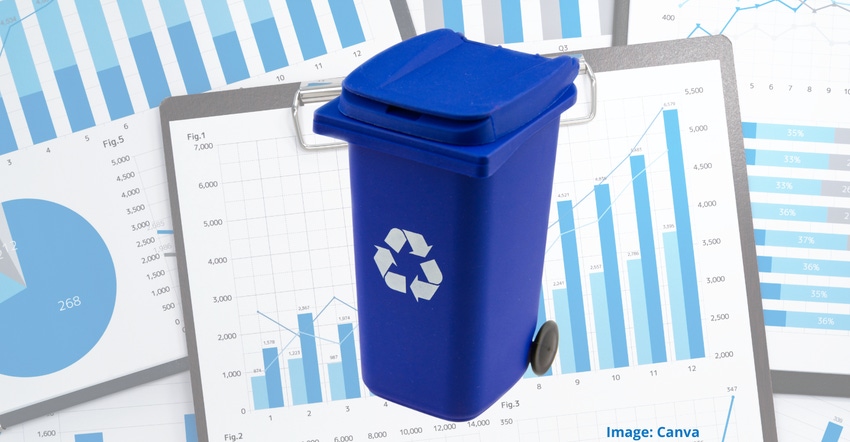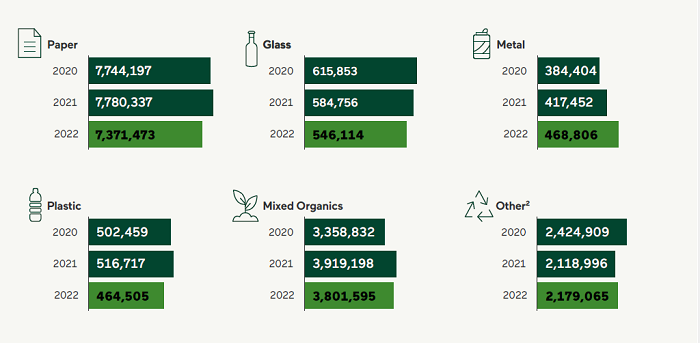5 Things to Know about WM’s 2023 Sustainability Report
Recycling leader Waste Management is innovating with materials recovery that includes plastic film recycling and a focus on circularity.

Waste Management (WM), a US leader in residential/commercial recycling, is baking sustainability into its business model. The company’s 2023 Sustainability Report captures its achievements and goals and sheds light on WM’s creative approach to circularity and sustainability.
“In 2022, we refreshed our sustainability strategy, announcing planned financial investments and our commitment to sustainability initiatives,” wrote Tara Hemmer, WM’s chief sustainability officer, in the report’s CSO Message.
The company’s sustainability strategy focuses on three core ambitions:
Material is repurposed;
Energy is renewable;
Communities are thriving.
The strategy also includes “reimagining a circular economy by investing in and operating innovative recycling and waste solutions that fuel the continuous reuse of materials,” Hemmer added.
Additionally, WM is deploying technologies that use waste to produce energy and participating in environmental conservation and wildlife preservation projects.
The following five highlights from WM’s report illustrate the company’s pioneering approach to waste management, materials recovery, and plastics circularity.
1. WM's 2022 achievements.
Material repurposing:
WM recovered 14.8 million tons of material.
Invested $561 million in expanding recycling and developing renewable energy solutions.
Launched four new recycling-automation projects and a new recycling facility, for a total of 350,000 tons of new capacity annually.
Renewable energy:
WM reduced direct greenhouse gas (GHG) emissions (Scope 1 and 2 GHG emissions, from a 2021 baseline) by 10%.
Provided 45% beneficial use of captured landfill gas.
Reached 42% renewable-electricity sourcing for WM’s operations, which the company reports is almost double the previous year.
Brought online the WM East Oak renewable natural gas facility in Oklahoma.
Became the first North American company in the waste management industry to have a climate target aligned with the 1.5°C trajectory of the Science Based Target initiative.
Communities:
WM conserved close to 13,500 acres of land through wildlife-habitat projects.
Made $15.9 million in philanthropic donations.
Supported more than 775 nonprofits across North America.
2. How materials recycling shakes out.
WM recycles not only plastic, but also paper, mixed organics, glass, metal, and more. In total, WM recycled 14,831,559 tons of materials in 2022. That included:
464,505 tons of plastic.
7,371,473 tons of paper.
3,801,595 tons of mixed organics.
546,114 tons of glass.
468,806 tons of metal.

3. Enabling a circular economy.
After collection and sortation, plastics and other materials can be the starting point for new consumer and industrial products. WM has developed processes to recycle harder-to-recycle items such as textiles, e-waste, fly ash, and construction and demolition waste.
Four most recycled items are plastic bottles, aluminum, paper products, and cardboard:
Plastic bottles may be recycled into new bottles, textiles, playground equipment, and outdoor decking.
Aluminum may be recycled into new cans and bottles indefinitely, without quality reduction.
Paper products may be recycled into packaging or other new paper products.
Cardboard may be recycled into corrugated board, chipboard, paperboard, writing/printing papers, paper towels, and tissues.
4. Gearing up for plastic film recycling.
WM is developing solutions for recycling plastic films, including stretch wrap, plastic wrap, and grocery bags.
The company acquired a controlling interest in Natura PCR, which manufactures post-consumer resin (PCR) pellets, in 2022. The acquisition positions WM to meet increased demand for film recycling and to supply PCR pellets, which are needed to boost recycled content in packaging.
WM is also leading collection and processing for several curbside film-recycling pilots across the United States and is focused on increasing film recycling to reach 8% of US households. When this program is operating at full capacity, it is expected to help WM capture more than 120,000 tons of plastic film for reuse.
WM also works with grocery stores on film collection and management, for potential recycling into new plastic film.
5. WM's goals for the future.
WM’s goals include increasing materials recovery by 60% to 25 million tons per year by 2030, with a 25% increase by 2025. Target increases are based on 2021, which established a baseline of 15,337,456 tons of materials recovered.
Climate goals include reducing Scope 1 and 2 GHG emissions 42% by 2031. The target reduction uses 2021 as a base year and includes land-related emissions and removals from bioenergy feedstocks. WM is also targeting beneficial use of 65% of its captured landfill gas by 2026.
WM’s community goals include making a positive impact on 10 million people within its communities by 2030 through targeted social impact programs, using the equivalent of 2% of the company’s net income. This goal will be reported from 2022 to 2030.
About the Author(s)
You May Also Like




